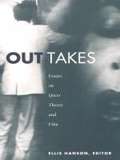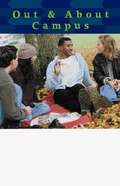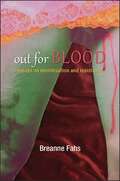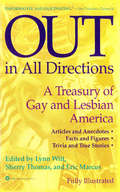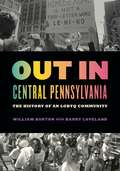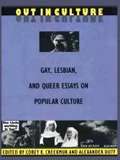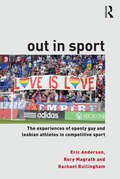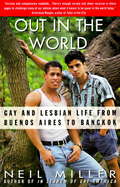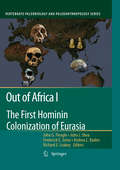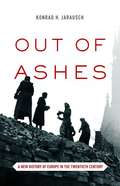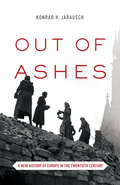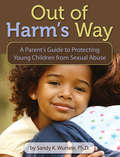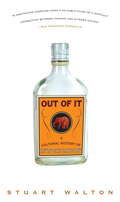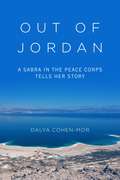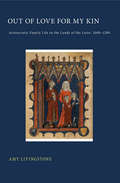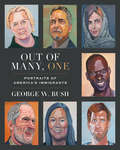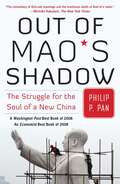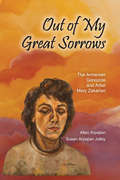- Table View
- List View
Out Takes: Essays on Queer Theory and Film
by Ellis HansonThis collection brings together the work of both film scholars and queer theorists to advance a more sophisticated notion of queer film criticism. While the "politics of representation" has been the focus of much previous gay and lesbian film criticism, the contributors to Out Takes employ the approaches of queer theory to move beyond conventional readings and to reexamine aspects of the cinematic gaze in relation to queer desire and spectatorship.The essays examine a wide array of films, including Calamity Jane, Rear Window, The Hunger, Heavenly Creatures, and Bound , and discuss such figures as Doris Day, Elizabeth Taylor, and Alfred Hitchcock. Divided into three sections, the first part reconsiders the construction of masculinity and male homoerotic desire--especially with respect to the role of women--in classic cinema of the 1940s and 1950s. The second section offers a deconstructive consideration of lesbian film spectatorship and lesbian representation. Part three looks at the historical trajectory of independent queer cinema, including works by H.D., Kenneth Anger, and Derek Jarman.By exploring new approaches to the study of sexuality in film, Out Takes will be useful to scholars in gay and lesbian studies, queer theory, and cinema studies.Contributors. Bonnie Burns, Steven Cohan, Alexander Doty, Lee Edelman, Michelle Elleray, Jim Ellis, Ellis Hanson, D. A. Miller, Eric Savoy, Matthew Tinkcom, Amy Villarejo, Jean Walton
Out and About Campus: Personal Accounts by Lesbian, Bisexual, and Transgendered College Students
by Kim Howard Annie StevensPersonal accounts of LBGT college students from around the U.S.
Out for Blood: Essays on Menstruation and Resistance (SUNY series, Praxis: Theory in Action)
by Breanne FahsFinalist for the 2016 Foreword INDIES Book of the Year Award in the Women's Studies categoryWinner of the 2017 Distinguished Publication Award presented by the Association for Women in PsychologyTransporting the reader to worlds in which Komodo dragons prey on menstruating women, artists prowl the streets of Spain in blood-stained pants, and the myths of women bleeding in synchrony with each other are drawn and redrawn, these eleven essays on menstruation and resistance evoke thought-provoking tensions between silence and confrontation, shame and rebellion, and compliance and disobedience. Fusing together gender and feminist theory, critical body studies, political activism, and menstrual anarchy, Breanne Fahs illuminates the troubling omissions of menstrual coming-of-age narratives in the museum, the outdated terminology of "feminine hygiene," and the moral panics about blood that erupts from in and outside of our bathrooms, classrooms, and cell phones. Borrowing from a multitude of voices—single moms, trans teenagers, zine makers, menstrual artists, college students, tour guides, French philosophers, and culture jammers—Fahs forcefully argues for a new culture of menstruation, one where the joys, rhythms, and controversies of menstrual cycles collides with the defiant, shameless, and bold new possibilities of menstrual resistance.
Out in Africa: LGBT Organizing in Namibia and South Africa (Social Movements, Protest and Contention #38)
by Ashley CurrierVisibility matters to activists—to their social and political relevance, their credibility, their influence. But invisibility matters, too, in times of political hostility or internal crisis. Out in Africa is the first to present an intimate look at how Namibian and South African lesbian, gay, bisexual, and transgender (LGBT) organizations have cultivated visibility and invisibility as strategies over time. As such, it reveals the complexities of the LGBT movements in both countries as these organizations make use of Western terminology and notions of identity to gain funding even as they work to counter the perception that they are &“un-African.&”Different sociopolitical conditions in Namibia and South Africa affected how activists in each country campaigned for LGBT rights between 1995 and 2006. Focusing on this period, Ashley Currier shows how, in Namibia, LGBT activists struggled against ruling party leaders&’ homophobic rhetoric and how, at the same time, black LGBT citizens of South Africa, though enjoying constitutional protections, greater visibility, and heightened activism, nonetheless confronted homophobic violence because of their gender and sexual nonconformity.As it tells the story of the evolving political landscape in postapartheid Namibia and South Africa, Out in Africa situates these countries&’ movements in relation to developments in pan-African LGBT organizing and offers broader insights into visibility as a social movement strategy rather than simply as a static accomplishment or outcome of political organizing.
Out in All Directions: A Treasury of Gay and Lesbian America
by Eric Marcus Lynn Witt Sherry ThomasThis volume takes the mystery out of gay and lesbian history, lifts the lid off pink politics, and paints the town lavender with hundreds of lively articles and intriguing facts covering every aspect of gay life, culture, and community. From debunking myths to creating family, from fighting for rights to battling AIDS, from showbiz superstars to military heroes, dozens of notable contributors come out in all directions -- providing both a useful guide to issues and resources and an entertaining and informative mirror of the American lesbian and gay experience.
Out in Central Pennsylvania: The History of an LGBTQ Community (Keystone Books)
by William BurtonOutside of major metropolitan areas, the fight for lesbian, gay, bisexual, and transgender rights has had its own unique and rich history—one that is quite different from the national narrative set in New York and California. Out in Central Pennsylvania highlights one facet of this lesser-known but equally important story, immersing readers in the LGBTQ community building and social networking that has taken place in the small cities and towns in the heart of Pennsylvania from the 1960s to the present day.Drawing from oral histories and the archives of the LGBT Center of Central PA History Project, this book recounts the innovative ways that LGBTQ central Pennsylvanians organized to demand civil rights and to improve their quality of life in a region that often rejected them. Full of compelling stories of individuals seeking community and grappling with inequity, harassment, and discrimination, and featuring a distinctive trove of historical photographs, Out in Central Pennsylvania is a local story with national implications. It brings rural and small-town queer life out into the open and explores how LGBTQ identity and social advocacy networks can form outside of a large urban environment.
Out in Central Pennsylvania: The History of an LGBTQ Community (Keystone Books)
by William BurtonOutside of major metropolitan areas, the fight for lesbian, gay, bisexual, and transgender rights has had its own unique and rich history—one that is quite different from the national narrative set in New York and California. Out in Central Pennsylvania highlights one facet of this lesser-known but equally important story, immersing readers in the LGBTQ community building and social networking that has taken place in the small cities and towns in the heart of Pennsylvania from the 1960s to the present day.Drawing from oral histories and the archives of the LGBT Center of Central PA History Project, this book recounts the innovative ways that LGBTQ central Pennsylvanians organized to demand civil rights and to improve their quality of life in a region that often rejected them. Full of compelling stories of individuals seeking community and grappling with inequity, harassment, and discrimination, and featuring a distinctive trove of historical photographs, Out in Central Pennsylvania is a local story with national implications. It brings rural and small-town queer life out into the open and explores how LGBTQ identity and social advocacy networks can form outside of a large urban environment.
Out in Culture: Gay, Lesbian and Queer Essays on Popular Culture
by Corey K. Creekmur Alexander DotyOut in Culture charts some of the ways in which lesbians, gays, and queers have understood and negotiated the pleasures and affirmations, as well as the disappointments, of mass culture. The essays collected here, combining critical and theoretical works from a cross-section of academics, journalists, and artists, demonstrate a rich variety of gay and lesbian approaches to film, television, popular music, and fashion. This wide-ranging anthology is the first to juxtapose pioneering work in gay and lesbian media criticism with recent essays in contemporary queer cultural studies.Uniquely accessible, Out in Culture presents such popular writers as B. Ruby Rich, Essex Hemphill, and Michael Musto as well as influential critics such as Richard Dyer, Chris Straayer, and Julia Lesage, on topics ranging from the queer careers of Agnes Moorehead and Pee Wee Herman to the cultural politics of gay drag, lesbian style, the visualization of AIDS, and the black snap! queen experience. Of particular interest are two "dossiers," the first linking essays on the queer content of Alfred Hitchcock's films, and the second on the production and reception of popular music within gay and lesbian communities. The volume concludes with an extensive bibliography--the most comprehensive currently available--of sources in gay, lesbian, and queer media criticism.Out in Culture explores the distinctive and original ways in which gays, lesbians, and queers have experienced, appropriated, and resisted the images and artifacts of popular culture. This eclectic anthology will be of interest to a broad audience of general readers and scholars interested in gay and lesbian issues; students of film, media, gender, and cultural studies; and those interested in the emerging field of queer theory.Contributors. Sabrina Barton, Edith Becker, Rhona J. Berenstein, Nayland Blake, Michelle Citron, Danae Clark, Corey K. Creekmur, Alexander Doty, Richard Dyer, Heather Findlay, Jan Zita Grover, Essex Hemphill, John Hepworth, Jeffrey Hilbert, Lucretia Knapp, Bruce La Bruce, Al LaValley, Julia Lesage, Michael Moon, Michael Musto, B. Ruby Rich, Marlon Riggs, Arlene Stein, Chris Straayer, Anthony Thomas, Mark Thompson, Valerie Traub, Thomas Waugh, Patricia White, Robin Wood
Out in Sport: The experiences of openly gay and lesbian athletes in competitive sport
by Eric Anderson Rory Magrath Rachael BullinghamResearch has shown that since the turn of the millennia, matters have rapidly improved for gays and lesbians in sport. Where gay and lesbian athletes were merely tolerated a decade ago, today they are celebrated. This book represents the most comprehensive examination of the experiences of gays and lesbians in sport ever produced. Drawing on interviews with openly gay and lesbian athletes in the US and the UK, as well as media accounts, the book examines the experiences of ‘out’ men and women, at recreational, high school, university and professional levels, in addition to those competing in gay sports leagues. Offering a new approach to understanding this important topic, Out in Sport is essential reading for students and scholars of sport studies, LGBT studies and sociology, as well as sports practitioners and trainers.
Out in Theory: The Emergence of Lesbian and Gay Anthropology
by Ellen Lewin William L. LeapA companion volume to Out in the Field, a benchmark examination of lesbian and gay experiences in anthropology, Out in Theory presents lesbian and gay anthropology as a distinct specialization and addresses the theoretical issues that define the emerging field. This compelling collection of essays details the scholarly and personal factors that affected the emergence of lesbian and gay anthropology and speculates on the directions it will take as it continues to grow and diversify. Seeking to legitimize the field's scholarship and address issues in terminology, the essays also define the lesbian and gay anthropology's scope and subject matter and locate factors that separate it from the wider concerns of the profession. Specific essays track the emergence of lesbian and gay studies in social and cultural anthropology, linguistics, archaeology, and in various areas of anthropological activism. They also consider how feminist anthropology helped define the field and how transgendered experience, queer theory, and race and class studies are promoting new directions of inquiry within lesbian and gay anthropology.
Out in the Country: Youth, Media, and Queer Visibility in Rural America (Intersections #2)
by Mary L. GrayWinner of the 2009 Ruth Benedict Prize for Outstanding Monograph from the Society of Lesbian and Gay AnthropologistsWinner of the 2010 Distinguished Book Award from the American Sociological Association, Sociology of Sexualities SectionWinner of the 2010 Congress Inaugural Qualitative Inquiry Book Award Honorable MentionAn unprecedented contemporary account of the online and offline lives of rural LGBT youthFrom Wal-Mart drag parties to renegade Homemaker’s Clubs, Out in the Country offers an unprecedented contemporary account of the lives of today’s rural queer youth. Mary L. Gray maps out the experiences of young people living in small towns across rural Kentucky and along its desolate Appalachian borders, providing a fascinating and often surprising look at the contours of gay life beyond the big city. Gray illustrates that, against a backdrop of an increasingly impoverished and privatized rural America, LGBT youth and their allies visibly—and often vibrantly—work the boundaries of the public spaces available to them, whether in their high schools, public libraries, town hall meetings, churches, or through websites. This important book shows that, in addition to the spaces of Main Street, rural LGBT youth explore and carve out online spaces to fashion their emerging queer identities. Their triumphs and travails defy clear distinctions often drawn between online and offline experiences of identity, fundamentally redefining our understanding of the term ‘queer visibility’ and its political stakes. Gray combines ethnographic insight with incisive cultural critique, engaging with some of the biggest issues facing both queer studies and media scholarship. Out in the Country is a timely and groundbreaking study of sexuality and gender, new media, youth culture, and the meaning of identity and social movements in a digital age.
Out in the World: Gay and Lesbian Life from Buenos Aires to Bangkok
by Neil MillerA journalistic account of gay and lesbian life in the diverse gay communities of Thailand, Germany, Argentina, South Africa, Australia, and other locales, sheds light on the cultural, political, and social factors influencing gay life.
Out of Africa I
by Richard E. Leakey John J. Shea Andrea L. Baden John G. Fleagle Frederick E. GrineFor the first two thirds of our evolutionary history, we hominins were restricted to Africa. Dating from about two million years ago, hominin fossils first appear in Eurasia. This volume addresses many of the issues surrounding this initial hominin intercontinental dispersal. Why did hominins first leave Africa in the early Pleistocene and not earlier? What do we know about the adaptations of the hominins that dispersed - their diet, locomotor abilities, cultural abilities? Was there a single dispersal event or several? Was the hominin dispersal part of a broader faunal expansion of African mammals northward? What route or routes did dispersing populations take?
Out of Ashes
by Konrad H. JarauschA sweeping history of twentieth-century Europe, Out of Ashes tells the story of an era of unparalleled violence and barbarity yet also of humanity, prosperity, and promise.Konrad Jarausch describes how the European nations emerged from the nineteenth century with high hopes for continued material progress and proud of their imperial command over the globe, only to become embroiled in the bloodshed of World War I, which brought an end to their optimism and gave rise to competing democratic, communist, and fascist ideologies. He shows how the 1920s witnessed renewed hope and a flourishing of modernist art and literature, but how the decade ended in economic collapse and gave rise to a second, more devastating world war and genocide on an unprecedented scale. Jarausch further explores how Western Europe surprisingly recovered due to American help and political integration. Finally, he examines how the Cold War pushed the divided continent to the brink of nuclear annihilation, and how the unforeseen triumph of liberal capitalism came to be threatened by Islamic fundamentalism, global economic crisis, and an uncertain future.A stunning achievement, Out of Ashes explores the paradox of the European encounter with modernity in the twentieth century, shedding new light on why it led to cataclysm, inhumanity, and self-destruction, but also social justice, democracy, and peace.
Out of Ashes: A New History of Europe in the Twentieth Century
by Konrad H. JarauschA sweeping history of twentieth-century Europe, Out of Ashes tells the story of an era of unparalleled violence and barbarity yet also of humanity, prosperity, and promise.Konrad Jarausch describes how the European nations emerged from the nineteenth century with high hopes for continued material progress and proud of their imperial command over the globe, only to become embroiled in the bloodshed of World War I, which brought an end to their optimism and gave rise to competing democratic, communist, and fascist ideologies. He shows how the 1920s witnessed renewed hope and a flourishing of modernist art and literature, but how the decade ended in economic collapse and gave rise to a second, more devastating world war and genocide on an unprecedented scale. Jarausch further explores how Western Europe surprisingly recovered due to American help and political integration. Finally, he examines how the Cold War pushed the divided continent to the brink of nuclear annihilation, and how the unforeseen triumph of liberal capitalism came to be threatened by Islamic fundamentalism, global economic crisis, and an uncertain future.A gripping narrative, Out of Ashes explores the paradox of the European encounter with modernity in the twentieth century, shedding new light on why it led to cataclysm, inhumanity, and self-destruction, but also social justice, democracy, and peace.
Out of Care: The Community Support of Juvenile Offenders (Routledge Revivals)
by D. Smith D. H. Thorpe C. J. Green J. H. PaleyThe late 1970s saw the emergence of a heated debate on the treatment of juvenile delinquents. The argument was usually presented as being between the exponents of ‘law and order’ and punishment on the one hand, and the ‘soft’ advocates of social work and treatment on the other. Originally published in 1980, Out of Care: The Community Support of Juvenile Offenders took issue with both sides and argued that it was the juvenile justice system itself which was at fault. Much of the debate about the merits or otherwise of the 1969 Children and Young Persons Act had been conducted in an informational vacuum. For the authors, the most important point is that while this self-interested and politically disingenuous debate had been continuing more and more supposedly delinquent children had been locked up, quite contrary to the intentions of the Act.The book, however, goes further than a mere critique of the existing system at the time. It also offers very direct and practical advice on what can be done – advice aimed at the police and magistrates, and especially at social workers and probation officers, both agency managers and field level practitioners. It describes practical ways of collecting information to modify local policies and suggests innovative and imaginative ways of working face to face with juvenile offenders. The book is unusual in that it combines this practical usefulness with a detailed analysis of certain key themes in contemporary criminological theory.All the authors had backgrounds in social work or probation practice, as well as recent experience of research into intermediate treatment and the workings of the juvenile justice system at the time. They were therefore able to offer a unique combination of perspectives, drawing on social policy, theories of delinquency, justice and the state, field research and social work practice.
Out of Darkness: Rumana Monzur's Journey through Betrayal, Tyranny and Abuse
by Denise ChongFrom the bestselling author of The Concubine&’s Children and The Girl in the Picture, a gripping story of a domestic assault that shocked the world, of the exercise of power and political influence, and of the Bangladeshi woman whose irrepressible spirit found light in sudden darkness.From the outside, Rumana seemed an unlikely victim of domestic abuse: married to a man of her own choosing and progressing in her career as a professor of international relations at Dhaka University. But in 2011, on return from graduate studies at the University of British Columbia, her husband attacked and blinded her in front of their young daughter. As Rumana's horrifying story garnered international headlines, and connections brought her to Vancouver in an attempt—ultimately futile—to restore her sight, her plight underscored the fact that there are no typical victims of intimate-partner violence. Denise Chong goes behind the headlines to reveal the devolution of a love story into a tale of tyranny behind closed doors, and the pursuit of justice that proved all the more elusive during the rise of social media. Out of Darkness tells a globe-spanning narrative of loyalty, perseverance and a woman&’s determination to face the future and rebuild a life with meaning.
Out of Exile
by Dave Eggers Craig Walzer Valentino Achak DengMillions of people have fled from conflicts and persecution in all parts of the Northeast African country of Sudan, and many thousands more have been enslaved as human spoils of war. Here, in their own words, men and women recount life before their displacement and the reasons for their flight, and provide insight on the major stations of the "refugee railroads" - the desert camps of Khartoum, the underground communities of Cairo, the humanitarian metropolis of Kakuma refugee camp, and the still-growing internally displaced persons camps in Darfur. Included are stories of escapes from the wars in Darfur and South Sudan, from political and religious persecution, and from abduction by paramilitary groups.
Out of Harm’s Way
by Sandy K. WurteleThis frank study authoritatively and objectively examines the heinous crime of child sexual abuse, explaining how, far from being the stereotypical "dirty old man" or pedophile, many child molesters aren’t so easy to detect. Without resorting to scare tactics or jargon, abuse prevention expert Sandy Wurtele describes how community members and extended family members might groom a child for abuse, gradually increasing the inappropriateness of physical contact. The straightforward information provided in this book will help parents increase their awareness of such grooming and discuss it with children.
Out of It: A Cultural History of Intoxication
by Stuart WaltonOut of It offers a contrarian, controversial look at the role of intoxicating drugs in human society, throughout history, and today. Who will ever relate the history of narcotica?" asked Nietzsche, adding that it is almost the history of culture itself. In this engaging and often surprising consideration of intoxication, Stuart Walton shines a penetrating light on the history of drug use, from ancient Greece and Rome to the Victorian era to our own time, from alcohol, caffeine, and tobacco to opiates, amphetamines, and hallucinogens. Does the ritual and recreational use of intoxicants have a legitimate and necessary role in our lives? Do efforts to stamp out such behavior cause more harm than good? In the wake of the multibillion-dollar "War on Drugs, " why has the illicit drug market only expanded? Drawing on anthropological, sociological, medical, and historical research, Walton arrives at answers that cut across the grain of today's prevailing attitudes on the subject.
Out of Jordan: A Sabra in the Peace Corps Tells Her Story
by Dalya Cohen-MorA riveting memoir of the first Israeli-born Jewish American to be sent as a Peace Corps volunteer to a closed Arab society. A good memoir is a survivor’s tale--the story of a person who has faced obstacles and made it through well enough to tell it. Dalya Cohen-Mor, a Sabra-born American woman, volunteered to serve in the Peace Corps, went through a lengthy and highly competitive application process, was accepted, and was sent to serve in the predominantly Palestinian country Jordan, of all countries. Upon arrival in Jordan, Cohen-Mor was instructed by Peace Corps supervisors to conceal her Jewish identity, use an alias instead of her real last name, and pretend that she was Christian so as not to compromise her safety and efficacy as a Peace Corps volunteer. As a single woman, a Sabra, and an American Peace Corps volunteer in a conservative Arab society, Cohen-Mor was forced to navigate unchartered territory, redefine her values and attitudes, and discover what it means to be perceived as the Other. She lived in the household of a Bedouin host family in a remote village in the eastern desert of Jordan, teaching English at the village girls’ elementary school. As she traveled around the Kingdom, she often found herself in delicate, complicated, and dangerous situations. After three months of hard work in the Peace Corps, she was accused of being involved in intelligence activities and unceremoniously sent back home. Although she lost her dream to serve in the Peace Corps, she found something more precious in the process: her core identity and sense of self. Out of Jordan paints a penetrating portrait of contemporary life in Jordan, with insight into the complexities of a closed Arab society--family life, women’s roles, the Arab-Israeli conflict, and the perception of America in the minds of ordinary people. With relentless honesty and unflinching courage, Cohen-Mor recounts her personal journey across borders and cultures into the living realities of two peoples--Arabs and Jews--with conflicting national identities but a common humanity. Skyhorse Publishing, as well as our Arcade imprint, are proud to publish a broad range of books for readers interested in history--books about World War II, the Third Reich, Hitler and his henchmen, the JFK assassination, conspiracies, the American Civil War, the American Revolution, gladiators, Vikings, ancient Rome, medieval times, the old West, and much more. While not every title we publish becomes a New York Times bestseller or a national bestseller, we are committed to books on subjects that are sometimes overlooked and to authors whose work might not otherwise find a home.
Out of Love for My Kin: Aristocratic Family Life in the Lands of the Loire, 1000–1200
by Amy LivingstoneIn Out of Love for My Kin, Amy Livingstone examines the personal dimensions of the lives of aristocrats in the Loire region of France during the eleventh and twelfth centuries. She argues for a new conceptualization of aristocratic family life based on an ethos of inclusion. Inclusivity is evident in the care that medieval aristocrats showed toward their families by putting in place strategies, practices, and behaviors aimed at providing for a wide range of relatives. Indeed, this care--and in some cases outright affection--for family members is recorded in the documents themselves, as many a nobleman and woman made pious benefactions "out of love for my kin." In a book made rich by evidence from charters--which provide details about life events including birth, death, marriage, and legal disputes over property--Livingstone reveals an aristocratic family dynamic that is quite different from the fictional or prescriptive views offered by literary depictions or ecclesiastical sources, or from later historiography. For example, she finds that there was no single monolithic mode of inheritance that privileged the few and that these families employed a variety of inheritance practices. Similarly, aristocratic women, long imagined to have been excluded from power, exerted a strong influence on family life, as Livingstone makes clear in her gender-conscious analysis of dowries, the age of men and women at marriage, lordship responsibilities of women, and contestations over property. The web of relations that bound aristocratic families in this period of French history, she finds, was a model of family based on affection, inclusion, and support, not domination and exclusion.
Out of Many, One: Portraits of America's Immigrants
by George W. BushIn this powerful new collection of oil paintings and stories, President George W. Bush spotlights the inspiring journeys of America’s immigrants and the contributions they make to the life and prosperity of our nation. <P><P>The issue of immigration stirs intense emotions today, as it has throughout much of American history. But what gets lost in the debates about policy are the stories of immigrants themselves, the people who are drawn to America by its promise of economic opportunity and political and religious freedom—and who strengthen our nation in countless ways. <P><P>In the tradition of Portraits of Courage, President Bush’s #1 New York Times bestseller, Out of Many, One brings together forty-three full-color portraits of men and women who have immigrated to the United States, alongside stirring stories of the unique ways all of them are pursuing the American Dream. <P><P>Featuring men and women from thirty-five countries and nearly every region of the world, Out of Many, One shows how hard work, strong values, dreams, and determination know no borders or boundaries and how immigrants embody values that are often viewed as distinctly American: optimism and gratitude, a willingness to strive and to risk, a deep sense of patriotism, and a spirit of self-reliance that runs deep in our immigrant heritage. In these pages, we meet a North Korean refugee fighting for human rights, a Dallas-based CEO who crossed the Rio Grande from Mexico at age seventeen, and a NASA engineer who as a girl in Nigeria dreamed of coming to America, along with notable figures from business, the military, sports, and entertainment. <P><P>President Bush captures their faces and stories in striking detail, bringing depth to our understanding of who immigrants are, the challenges they face on their paths to citizenship, and the lessons they can teach us about our country’s character. As the stories unfold in this vibrant book, readers will gain a better appreciation for the humanity behind one of our most pressing policy issues and the countless ways in which America, through its tradition of welcoming newcomers, has been strengthened by those who have come here in search of a better life. <P><P><b>A New York Times Best Seller</b>
Out of Mao's Shadow: The Struggle for the Soul of a New China
by Philip P. PanFrom an award-winning journalist for The Washington Post and one of the leading China correspondents of his generation comes an eloquent and vivid chronicle of the world's most successful authoritarian state -- a nation undergoing a remarkable transformation. Philip P. Pan's groundbreaking book takes us inside the dramatic battle for China's soul and into the lives of individuals struggling to come to terms with their nation's past -- the turmoil and trauma of Mao's rule -- and to take control of its future. Capitalism has brought prosperity and global respect to China, but the Communist government continues to resist the demands of its people for political freedom. Pan, who reported in China for the Post for seven years and speaks fluent Chinese, eluded the police and succeeded in going where few Western journalists have dared. From the rusting factories in the industrial northeast to a tabloid newsroom in the booming south, from a small-town courtroom to the plush offices of the nation's wealthiest tycoons, he tells the gripping stories of ordinary men and women fighting for political change. An elderly surgeon exposes the government's cover-up of the SARS epidemic. A filmmaker investigates the execution of a young woman during the Cultural Revolution. A blind man is jailed for leading a crusade against forced abortions carried out under the one-child policy. The young people who filled Tiananmen Square in the spring of 1989 saw their hopes for a democratic China crushed in a massacre, but Pan reveals that as older, more pragmatic adults, many continue to push for justice in different ways. They are survivors whose families endured one of the world's deadliest famines during the Great Leap Forward, whose idealism was exploited during the madness of the Cultural Revolution, and whose values have been tested by the booming economy and the rush to get rich.
Out of My Great Sorrows: The Armenian Genocide and Artist Mary Zakarian (Armenian Studies)
by Allan Arpajian Susan Arpajian JolleyOut of My Great Sorrows is the story of Philadelphia artist Mary Zakarian, whose life and work were shaped by the experiences of her mother, a survivor of the 1915 Armenian Genocide. Written by Mary Zakarian's niece and nephew, the narrative examines the complexities of the artist's life as they relate to many issues, including ethnicity, gender, immigration, and assimilation. Above all this is a story of trauma - its effects on the survivor, its transmission through the generations, and its role in the artistic experience. Zakarian painted obsessively throughout her life. As she gained recognition for her artwork, she became increasingly haunted by her mother's untold story and was driven to express the tragedy of the Armenian Genocide in her art. Zakarian's attempt to deal openly with the issues of trauma and guilt caused conflicts in her relationship with her mother. These emotions became a driving force behind her art as well as the basis for her personal difficulties. By examining Mary Zakarian's life and art, the authors bring new insights to the study of the Armenian experience. This moving story will inspire all those who have struggled to express themselves in the face of injustice and oppression.
